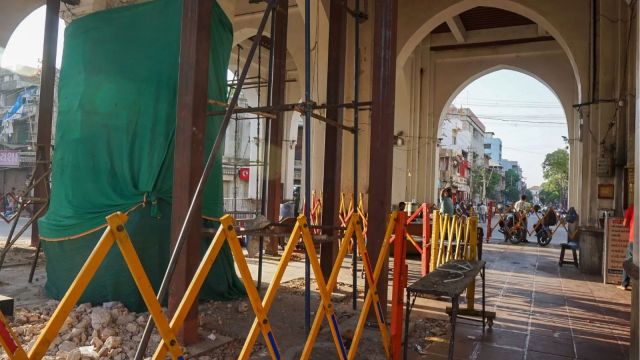Workers spot signs of rodent infestation as civic body begins emergency repairs on 15th-century Mandvi gate in Vadodara
Heritage conservationists say the changing ground water level due to 2024 floods could also have a major role to play in the weakening columns of the structure
 VMC Commissioner Arun Mahesh Babu said that the civic body is “serious” and working out the best possible restoration plan for Mandvi gate (Express Photo)
VMC Commissioner Arun Mahesh Babu said that the civic body is “serious” and working out the best possible restoration plan for Mandvi gate (Express Photo)Rodent infestation could be among the reasons behind the deterioration of the 15th-century Mandvi gate, which has been showing signs of “column crushing” since April and a part of which gave way on August 19, officials of the Vadodara Municipal Corporation (VMC) said.
Some heritage conservationists in the city believe that the changing ground water level due to 2024 floods could also have a major role to play in the weakening columns of the structure.
The VMC, meanwhile, began emergency repairs of the iconic structure on Thursday.
Even as the civic body is yet to issue a formal tender for the restoration of the monument, it has instructed Savani Heritage — the agency hired to assist in preparing a structural report — to undertake immediate repair works.
Officials of the VMC told The Indian Express that workers on the site found signs of rodent infestation in the structure that could be “among the reasons” for its deterioration.
An official of the VMC, on the condition of anonymity, said, “The team working on the immediate repair of the crumbling pillar has found some spots of rodent infestation and it will be a vital aspect while restoring the structure…”
The official said that the team has begun supporting the weakened pillars, especially the central column, with metal plates that will be filled with a “mixture of strengthening material that is close to the original limestone structure.”
VMC Commissioner Arun Mahesh Babu said that the civic body is “serious” and working out the best possible restoration plan for Mandvi gate.
Babu said, “In July, the consultant did not provide us with the details of the exact kind of structural repair that needs to be undertaken. So currently, we are in an advanced stage of in-depth examination in order to re-establish the strength of the structure. We will also be going for a 25-year guarantee period for the structure… The current repairs that have been undertaken are extremely necessary as the structure needs to be supported immediately but the restoration will be done keeping in mind its life in the long term.”
A conservationist, who is in the know of the restoration project, said, “The floods witnessed by Vadodara city in August 2024 significantly impacted the ground water table. The movement of the groundwater has impacted the foundation and the earth below the Mandvi gate … The Detailed Project Report of the VMC must look into all aspects and determine the cause or multiple issues that need to be addressed to ensure its long life… We have already lost four months.”
Since earlier this year Mandvi gate, which blends Islamic and Gaekwad-period architecture, has been supported by metal beams under its arches by the civic body. The gate features intricately carved arches, stonework and captivating stories of the now-extinct Kila-e-Daulatabad from the times of the Mughal Sultanate in Gujarat.
Derived from the Sanskrit word meaning a ‘pillared hall’ or ‘mandap’, Mandvi — spread over 4,000 square feet — is believed to have been designed by Rumin Khan, inspired by ancient Indian game Pachisi (a form of Ludo), which was extremely popular during the Mughal era. Thus, Mandvi gate stood at the centre of four intersecting streets aligned to meet at the mandap, and divided the area into smaller squares. While the structure initially had wooden parts in its original design, as the Gaekwads expanded the gate after establishing their rule in 1736 AD, they replaced wood with concrete in many parts, except the intricately carved wooden screens or jaalis.







